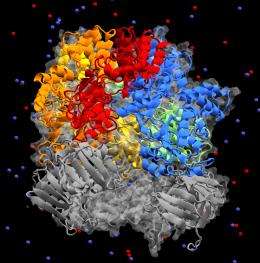Special report highlights 'greatest hits' of scientific supercomputing

In 2007, a report that concluded that the Earth was warming, probably as a result of human activities, resulted in a share of the Nobel Peace Prize. The United Nations Intergovernmental Panel on Climate Change's next assessment, expected in 2014, once again includes simulation data generated from DOE leadership supercomputers, this time at Oak Ridge and Argonne national laboratories. Next a team of researchers, led by Warren Washington of the National Center for Atmospheric Research, will use a 2011 allocation of 110 million processor hours at Argonne and Oak Ridge to begin the generation of the largest treasure trove of climate data to date.
The computational climate project is one of 22 "greatest hits" highlighted in a special report of science and engineering accomplishments of researchers running large, complex, and often unprecedented simulations on Department of Energy Office of Science supercomputers. The research community gains access to these powerful high-performance computing systems through the Innovative and Novel Computational Impact on Theory and Experiment (INCITE) program, which is jointly managed by the Argonne Leadership Computing Facility (ALCF) at Argonne National Laboratory and the Oak Ridge Leadership Computing Facility (OLCF) at ORNL. The 64-page report, INCITE in Review, is available online.
Because INCITE projects address the grand challenges of our time, they attract high-caliber callouts. "At Oak Ridge National Laboratory," President Obama said in his 2011 State of the Union Address, "they're using supercomputers to get a lot more power out of our nuclear facilities." "They," in this context, is the Consortium for Advancement Simulation of Light Water Reactors, an ORNL-based collaboration of national laboratories, universities, private industry, and other organizations. ORNL physicist Thomas Evans and colleagues use Denovo, an application that solves the Boltzmann equation describing the statistical distribution of individual particles in a fluid, to simulate radiation.
"Whether it's gaining a better understanding of the universe or engineering solutions for a growing, energy-hungry populace, the investigations enabled by INCITE are making the world a smarter, more sustainable place," James J. Hack, director of the National Center for Computational Sciences, which houses the OLCF, wrote in the report's introduction, with Michael E. Papka, director of the ALCF, and Julia C. White, INCITE program manager. "We are proud to tell the story of INCITE's role to date in advancing the frontiers of human knowledge for the benefit of all."
The report highlights simulations to make personalized genomics quick and affordable; explore corrosion in building materials; model carbon sequestration underground; and develop next-generation catalysts, semiconductors, and nuclear reactors for fission and fusion. Some projects elucidate biomass conversion for energy production and supercapacitors for energy storage, whereas others contribute to a deeper understanding of phenomena from earthquakes to supernovas.
Since 2003 INCITE has promoted transformational advances in science and technology through large allocations of computer time, supporting resources, and data storage. From modeling hurricanes that put people and property at risk to simulating combustion instabilities in power plant turbines and vehicle engines, INCITE projects aim to accelerate breakthroughs in fields in which major advancements would not be probable or even possible without supercomputing.
With a modest start by today's standards, in 2004 three INCITE projects received a total of nearly 5 million processor hours from Lawrence Berkeley National Laboratory's National Energy Research Scientific Computing Center. Since 2008 the program has focused on leadership computing facilities, from which researchers can obtain the largest single-award time allocations available on powerful computing systems, including the OLCF's Cray XT5 (Jaguar) with 224,256 processing cores yielding a peak performance of 2.33 thousand trillion calculations each second and the ALCF's IBM Blue Gene/P (Intrepid) with 163,840 processing cores yielding a peak performance of 557 trillion calculations per second.
For the 2011 calendar year, 57 INCITE awardees received a total of 1.7 billion processor hours. The allocations averaged 27 million hours. From INCITE's inception through the end of 2011, researchers from academia, government laboratories, and industry will have been allotted more than 4.5 billion processor hours to speed innovations and discoveries.
Provided by Oak Ridge National Laboratory

















